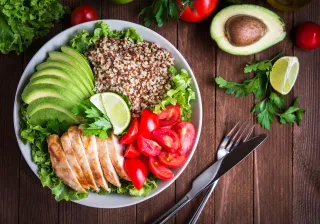The quantity of packaged foodstuffs is often described in terms of weight or volume. Many of us know that one litre carton of milk contains about 1 kg of milk. However, you cannot compare kilograms and litres with each other just like that. Comparing them is possible only if we know the density of the product. The World Metrology Day reminds us of how important various kind of measurements are for the global food system.
Just before Easter, the afternoon paper Iltasanomat (IS) reported on a great stir in social media about the actual weight of a bag of potatoes [1]. Inspired by the debate, IS randomly picked up some food packages from grocery stores, studied their markings concerning quantity and compared them with the actual contents. What caught my eye were particularly the results concerning milk cartons: the quantity of milk was studied by weighing the contents, i.e., by measuring the quantity of milk in kilograms (or grams) even though in the packages the quantity is announced in litres, which is a measure of volume. In order to compare these two quantities with each other, you should know the density of milk: the mass is calculated by multiplying the volume by the density.
At home, many of us are used to estimating how much a specific object weighs by comparing it to the weight of a one litre milk carton. This is a quite functional method since the density of milk is roughly 1 kg/litre, meaning that the mass of one litre of milk is about 1 kg. If, on the other hand, you buy strawberries measured in litres, the mass of the strawberries in your punnet will probably differ greatly each time because the varying size and shape of strawberries significantly affect the overall density of the portion of strawberries.
Reliable measuring is the precondition for functional food supply system
Even though, at first glance, it might seem easy and handy to measure volume using a measuring vessel of the known volume, in most cases weighing, or measuring the mass, would still be a more accurate way of determining the quantity of a product. This mainly derives from the fact that filling the measure is often inaccurate, and temperature significantly affects the volume of the measuring vessel and the substance being measured.
The mass of many dry substances, such as flour, is greatly affected by their moisture content. The same quantity of grain measured in kilograms yields much less flour when it has a higher moisture content. The annual global production of wheat amounts to almost 800 million tonnes [2], and its market value is around EUR 200 billion. By selling wheat with a slightly higher moisture content, a producer could earn better returns from his wheat, while also saving a lot of energy in the demanding drying process. On the other hand, the buyer of wheat would need to buy a higher quantity of the product to get the same amount of flour, which means that his expenses would rise.
In other words, both moisture content and density are important – but not the only – parameters describing the quality of grain measured in cereal trade in addition to mass. Ensuring the reliability of these measurements in a globally credible manner is the prerequisite for functional trading in cereals and, therefore, for global food supply.
Safe food at a fair price
Let us go back to the milk cartons weighed by IS. Some years back, I shifted to using almost exclusively fat-free milk (except for making the rice pudding at Christmas). More recently, I have started to increasingly favour oat milk. On my path towards the change, I have taken up the habit of examining the nutrition information on the side of the carton when doing my grocery shopping. It makes the comparison much easier that the unit used for describing the quantity of, for example, fat is always the same, i.e., gramme, even though the quantity of milk is given in litres. It makes it easier to compare different products and product sizes with each other that the nutrition information describes the quantity of fat per hundred grammes of milk. Quality assurance in production combined with the supervision of authorities ensures that I can rely on these facts to a sufficient extent.
This year, World Metrology Day, celebrated on 20 May, is dedicated to the measurement activities that ensure the functioning of the global food system. Reliable measurements are important not only for fair pricing of food but also for the safety of the food we consume. You can read more about the subject in the article (in Finnish) published jointly by the Finnish Food Authority, Radiation and Nuclear Safety Authority, Finnish Environment Institute (SYKE), Finnish Customs, Finnish Safety and Chemicals Agency, and VTT.
---
[1] https://www.is.fi/ruokala/ajankohtaista/art-2000009506369.html
[2] https://www.vyr.fi/fin/markkinatietoa/viljataseet/maailma/







